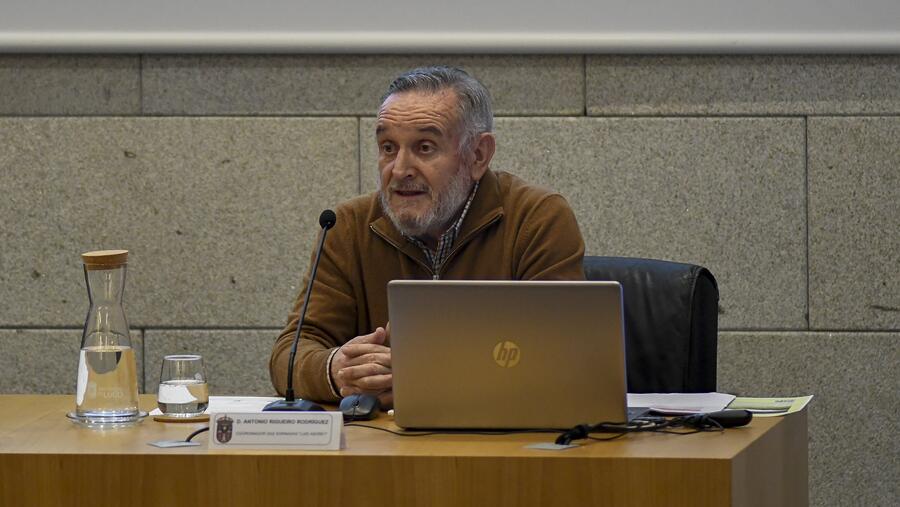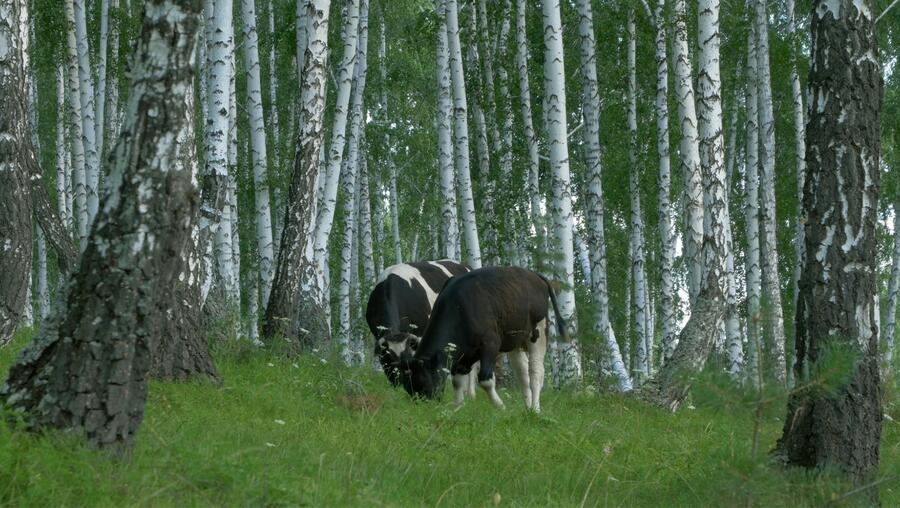Antonio Rigueiro: «Silvopastoral systems remain an important technique for improving the economic, social, and environmental performance of forests»

Forest fires, soil degradation, climate change, rural depopulation, loss of biodiversity... The challenges facing Galician forests today are far from few. And the magnitude of their consequences is becoming increasingly apparent.
For this reason, promoting the development of sustainable forest management methods, such as properly planned silvopastoral systems, is essential. And few people are as familiar with this reality as Antonio Rigueiro Rodríguez.
Professor Emeritus of the Department of Plant Production and Engineering Projects at Campus Terra and current president of the Forestry Association of Galicia, Antonio Rigueiro, has an impressive scientific and academic career spanning more than four decades of excellence, dedication, and sharing of invaluable knowledge.
Today, we draw on his expert voice to understand the benefits that silvopastoralism can bring to our forests, the current situation of forestry policies in Galicia, and how agroforestry research has evolved in recent years.
-After more than four decades of academic experience, how has your view of the role of silvopastoral systems in sustainable land management evolved?
-Agroforestry systems, in general, and silvopastoral systems, in particular, are sustainable forms of rural land management promoted by the EU, although in practice, they are applied to a greater extent in other autonomous communities and other countries.
Silvopastoral systems have evolved over time, incorporating native livestock breeds, with these techniques contributing to the conservation of animal genetic resources, as well as artificial intelligence and new technologies, such as virtual fencing and animal tracking using drones.
Currently, the demographic decline in rural areas, the aging population, and the abandonment of agriculture and livestock farming in many cases do not favor the implementation of these systems, with a few notable exceptions, as there are no shepherds or suitable livestock.
-You were a pioneer in Galicia in research on silvopastoralism. What ecological and productive advantages would you highlight in these systems compared to more intensive models?
-Well-planned silvopastoral systems remain an important technique for improving the economic performance of forests and reducing the risk of forest fires, while also promoting biodiversity conservation, soil conservation, and carbon storage, and restoring the role of shepherds, thereby stabilizing the rural population.
From an economic point of view, we add animal production to that of wood, which does not usually decrease due to the presence of livestock, and we also improve the production of some non-wood forest products, such as mushrooms.
-Your research group addresses issues such as plant biodiversity, climate change, and fire prevention. How are these lines integrated into a common strategy for rural development?
-EU and member state policies in the field of rural development tend to be increasingly concerned with nature conservation, the environment, genetic resources, and landscapes, as well as climate change mitigation and forest fire prevention. We believe and have demonstrated that agroforestry systems, in general, and silvopastoral systems, in particular, are good allies in achieving these objectives.
The EU is also committed to organic farming and livestock production, setting a target for 25% of plant and animal food products to come from this type of agriculture by 2030 and for livestock products, mainly meat, from many silvopastoral systems to meet organic livestock standards.
-You have supervised more than 25 doctoral theses, including some by international postgraduate students. What value does the global dimension bring to agroforestry research?
-Agroforestry research has developed significantly around the world in recent decades because agroforestry models or practices fit in with the prevailing philosophy of economic, environmental, and social sustainability, making use of natural resources without compromising their use by future generations.
Our group has been contributing to the knowledge and advancement of these techniques, with worldwide recognition, although we have not abandoned technology transfer at the local level.
-Among your many publications, are there any that you consider particularly influential in the projection of silvopastoralism at the national or European level?
-As I mentioned earlier, the nearly one hundred publications in renowned journals in which I appear as co-author, together with other colleagues, have led our research group to a position of leadership at the regional, national, and even international level, which I consider very important. In fact, my successor as group coordinator, Professor María Rosa Mosquera Losada, coordinates or participates in many EU projects and travels the world attending meetings or giving lectures by invitation.
But I am no less satisfied with the numerous publications I have authored or co-authored (books, book chapters, articles in magazines, press articles) in which we make available to rural stakeholders in Galicia and other Spanish autonomous communities the advances we are making in improving agroforestry and silvopastoral systems.

-Knowledge transfer has been a constant feature of your career. What mechanisms do you consider most effective in ensuring that scientific results actually reach the agroforestry sector?
-In Galicia, rural people are often skeptical when it comes to recognizing the value of innovations and, above all, when it comes to applying them on their farms. They don't believe until they see, like Saint Thomas.
That is why I believe that an effective way of transferring technology in our region, without ruling out other equally important methods (meetings, seminars, conferences, information leaflets, etc.), is through demonstration plots, a task that was successfully carried out by the Agricultural Extension Service until it practically disappeared from the countryside.
In some countries, universities play an important role in the field of agricultural extension, an area in which the Campus Terra could become even more involved.
-In your teaching career, you have covered everything from sheep farming to macromycology. How do you manage to keep the training content up to date in such a broad and constantly evolving field?
-In my case, I have been fortunate to teach subjects in which I have also been conducting research, which requires me to keep abreast of the latest developments and incorporate them into the course programs, keeping them up to date.
-As president of the Galician Forestry Association and a member of several advisory bodies, how do you assess the current state of forestry policies in Galicia in relation to science and technical knowledge?
-The truth is that I do not see significant direct attention from the Galician authorities in terms of support for forestry research. There is some regional task force, some consolidation aid for forestry research groups, something that comes through the specialization campus, some agreements or contracts, some funding from the provincial councils, and little else.
The Lourizán Forestry Research Center, which was a leading center for forest research at the regional, national, and global levels, is now languishing due to the departure and retirement of researchers.
I want to see some hope in a private-public applied forestry research body that is currently being set up and in which the Galician Regional Government, universities, CSIC centers, the Areeiro Phytopathological Station, and the Arume Foundation (which brings together forestry industries, nurseries, service companies, and landowners) are expected to participate.
-During your time as director of the Courel Scientific Station, what achievements would you highlight in relation to the conservation of flora and the promotion of scientific knowledge in mountain areas?
-During my time as director of the Courel Scientific Station in the field of science, I would highlight the significant attention we devoted to the study of macromycobiotic (mushrooms). In the series ‘Cuadernos de la Estación Científica del Courel’ (Courel Scientific Station Notebooks), we published the manual ‘Catálogo de la Macromicobiota de la Sierra del Courel’ (Catalogue of the Macromycobiotica of the Sierra del Courel), citing more than 500 species, with discoveries for the province, Galicia, Spain, and Europe. It is a reference work for researchers on macromycology in Galicia and Spain.
We also carried out many activities related to dissemination and technology transfer, notably several courses on edible and poisonous mushrooms and medicinal plants, which were very well received, and the four seminars on “Cultural Heritage of Courel.”
-Finally, as professor emeritus at the USC, what message would you convey to the new generations of researchers training at the Campus Terra with a vocation to contribute to a living and resilient rural environment?
-The truth is that these are not very good times for researchers in training, at least in my area of expertise, Plant Production, because there is a surplus of teaching staff and therefore, no new positions are being advertised and even those of retired teachers are being cut, a situation that will change in the coming years when there will be many retirements. There are few positions aimed at stabilizing researchers through teaching positions.
In this regard, I believe that the new statutes should include formulas for stabilizing researchers in addition to the path of becoming a professor, that is, differentiating between a research career and a teaching career.
On the other hand, it is clear that rural areas need research and technology transfer, especially in the age of artificial intelligence, so researchers in training at Campus Terra should not be discouraged, because although the beginnings are sometimes difficult, the future is promising.
